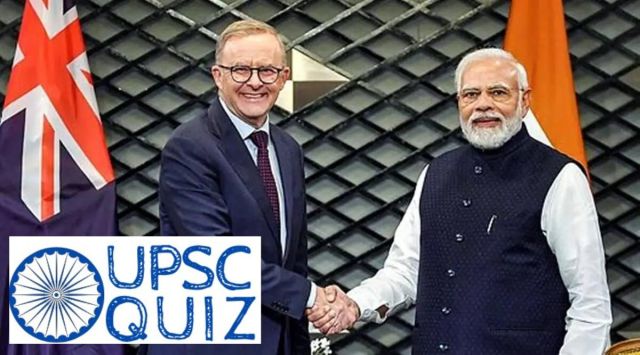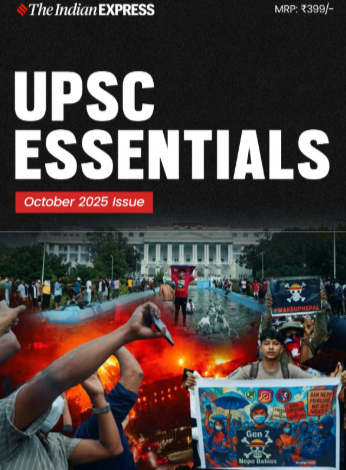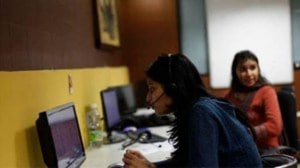Manas Srivastava leads the UPSC Essentials section of The Indian Express (digital). He majorly writes on UPSC, other competitive exams and education-related projects. In the past, Manas has represented India at the G-20 Youth Summit in Mexico. He is a former member of the Youth Council, GOI. A two-time topper/gold medallist in History (both in graduation and post-graduation) from Delhi University, he has mentored and taught UPSC aspirants for more than five years. His diverse role in The Indian Express consists of writing, editing, anchoring/ hosting, interviewing experts, and curating and simplifying news for the benefit of students. He hosts the YouTube talk show called ‘Art and Culture with Devdutt Pattanaik’ and a LIVE series on Instagram and YouTube called ‘LIVE with Manas’.His talks on ‘How to read a newspaper’ focus on newspaper reading as an essential habit for students. His articles and videos aim at finding solutions to the general queries of students and hence he believes in being students' editor, preparing them not just for any exam but helping them to become informed citizens. This is where he makes his teaching profession meet journalism. He is also the editor of UPSC Essentials' monthly magazine for the aspirants. He is a recipient of the Dip Chand Memorial Award, the Lala Ram Mohan Prize and Prof. Papiya Ghosh Memorial Prize for academic excellence. He was also awarded the University’s Post-Graduate Scholarship for pursuing M.A. in History where he chose to specialise in Ancient India due to his keen interest in Archaeology. He has also successfully completed a Certificate course on Women’s Studies by the Women’s Studies Development Centre, DU. As a part of N.S.S in the past, Manas has worked with national and international organisations and has shown keen interest and active participation in Social Service. He has led and been a part of projects involving areas such as gender sensitisation, persons with disability, helping slum dwellers, environment, adopting our heritage programme. He has also presented a case study on ‘Psychological stress among students’ at ICSQCC- Sri Lanka. As a compere for seminars and other events he likes to keep his orating hobby alive. His interests also lie in International Relations, Governance, Social issues, Essays and poetry. ... Read More
UPSC Weekly Quiz — March 6 to March 12, 2023
Brush up your knowledge on current events of the last week and consolidate your UPSC-CSE preparation. Find answers along with explanations at the end of the quiz.
 Albanese announced that Australia and the Indian government have finalised the Australia-India Education Qualification Recognition Mechanism. (Express Photo)
Albanese announced that Australia and the Indian government have finalised the Australia-India Education Qualification Recognition Mechanism. (Express Photo)UPSC Weekly Quiz is a current affairs-based quiz on certain relevant topics from the past week, curated for the aspirants of competitive examinations. Attempt the weekly quiz and find answers to the MCQs with explanations at the end of the article.
Question 1
Consider the following planets of the solar system:
1. Mercury
2. Mars
3. Neptune
4. Uranus
5. Saturn
6. Venus
7. Jupiter
Which of the above planets are Gas Giant Planets ?
(a) 3, 4, 5, 7
(b) 1, 3, 4, 6, 7
(c) 2, 3, 4, 5
(d) 2, 3, 5, 7
Question 2
Consider the following statements regarding Multi-Angle Imager for Aerosols missions (MAIA):
1. Mission will investigate the health impacts of air pollution in the world’s most populated cities.
2. MAIA marks an important moment in the long history of cooperation between NASA and ESA.
Which of the following statements are correct ?
(a) 1 only
(b) 2 only
(c) Both 1 and 2
(d) Neither 1 nor 2
Question 3
With which of the following state “Attukal Pongala” is associated :
(a) Tamil Nadu
(b) Kerala
(c) Karnataka
(d) Andhra Pradesh
Question 4
Supply Chain Resilience Initiative (SCRI) is seen in relation with:
(a) Pakistan, Russia and China
(b) Australia, India and Russia
(c) Japan, US and Australia
(d) Australia, Japan and India
Question 5
With reference to Landslide Atlas of India, consider the following statements:
1. Uttarakhand topped the list, recording maximum landslide events in the past 25 years.
2. It is released by National Disaster Management Authority.
Which of the above statements are incorrect?
(a) Only 1
(b) Only 2
(c) Both 1 and 2
(d) Neither 1 nor 2
Question 6
With reference to H3N2 virus, consider the following statements:
1. Influenza virus type A is further classified into different subtypes and one of them is the H3N2.
2. This virus usually preys on individuals below the age of 15 years or above 50 years of age.
Which of the above statements are correct?
(a) Only 1
(b) Only 2
(c) Both 1 and 2
(d) Neither 1 nor 2
Question 7
With reference to the recent amendments in the Prevention of Money Laundering Act (PMLA) consider the following statements:
1. The Finance Ministry has amended money laundering rules to incorporate more disclosures for non-governmental organisations by reporting entities like financial institutions, banking companies or intermediaries.
2. It has defined “politically exposed persons” (PEPs) under the Prevention of Money Laundering Act (PMLA) in line with the recommendations of the G20 Anti-Corruption Working Group.
Which of the above statements are correct?
(a) Only 1
(b) Only 2
(c) Both 1 and 2
(d) Neither 1 nor 2
Question 8
Which of the following statements with reference to ‘safe harbour’, recently seen in news, is/are correct?
1. It is prescribed under Section 79 of the IT Act, 2000 as a legal immunity that online intermediaries enjoy against content posted by users on their platforms.
2. The concept originally came from Section 230 of the United States’ Communications Decency Act, which has been termed “one of the foundational laws behind the modern Internet”.
(a) Only 1
(b) Only 2
(c) Both 1 and 2
(d) Neither 1 nor 2
Question 9
Consider the following pairs recently seen in news:
1. David Chipperfield : Pritzker Laureate 2023
2. Greg Becker : former England football player
3. Gary Lineker : the chief executive officer who presided over the collapsed Silicon Valley Bank
How many pairs above are not correctly match?
(a) Only one of the three pairs
(b) Only two of the above pairs
(c) All three of the above pairs
(d) None of the above three pairs
Question 10
With reference to Least Developed Countries (LDC), which of the following statements is not true?
(a) Bhutan will on December 13th, become the seventh nation to graduate from the United Nations’ (UN) list of Least Developed Countries (LDC).
(b) The UN identifies three criteria for a country to be classified as an LDC.
(c) LDCs are restricted by trade restrictions or tariffs when exporting their goods to wealthier nations.
(d) Currently, as per the UN lists the maximum LDCs are from Africa.
ANSWERS TO MCQs
1 (a)
FYI
In order to fill in what they consider a gap in the solar system, researchers at the University of California, Riverside (UCR) ran dynamic computer simulations of a fictional planet between Mars and Jupiter. They then found that the results would mostly be disastrous for the solar system in general, and Earth in particular.
The astrophysicists initially set out to address what they considered two noticeable gaps in planetary science. The first is a gap in the size of terrestrial and gas giant planets in the solar system. Neptune, the smallest gas giant, is four times wider and 17 times more massive than Earth, which is the largest terrestrial planet in the solar system.
Terrestrial Planets : Mercury, Venus, Earth and Mars
Gas Giant Planets : Neptune, Uranus, Saturn and Jupiter
2 (a)
FYI
NASA announced on Wednesday that it is partnering with the Italian Space Agency ASI (Agenzia Spaziale Italiana) to build and launch MAIA, or the Multi-Angle Imager for Aerosols missions. The joint mission between the two national space agencies will investigate the health impacts of air pollution in the world’s most populated cities.
3 (b)
FYI
Attukal Pongala, a 10-day religious festival (a festival of largest women gathering on earth), celebrated at the Attukal Bhagavathy Temple in Thiruvananthapuram in Kerala is extremely popular.
4 (d)
FYI
The Trade Ministers of India, Japan and Australia formally launched the Supply Chain Resilience initiative in a Trilateral Ministerial Meeting held virtually in 2021.
5 (c)
FYI
With a steady rise in the number of extreme weather events, especially heavy rainfall capable of triggering landslides and floods, the Indian Space Research Organisation (ISRO) recently released the Landslide Atlas of India, a detailed guide identifying landslide hotspots in the country.
Uttakarkhand, Kerala, Jammu and Kashmir, Mizoram, Tripura, Nagaland and Arunachal Pradesh reported the highest number of landslides during 1998 – 2022.
Mizoram topped the list, recording 12,385 landslide events in the past 25 years, of which 8,926 were recorded in 2017 alone. Likewise, 2,071 events of the total 2,132 landslides reported in Nagaland during this period occurred during the 2017 monsoon season. Manipur, too, showed a similar trend, wherein 4,559 out of 5,494 landslide events were experienced during the rainy season of 2017. Of the total 690, Tamil Nadu suffered 603 landslide events in 2018 alone.
Among all these states, an alarming situation is emerging from Uttarakhand and Kerala.

Top 30 districts based on exposure to landslides. (Source: Landslide Atlas of India)
While Uttarakhand’s fragility was recently exposed during the land subsidence events reported from Joshimath since January, this Himalayan state has experienced the second highest number (11,219) of landslides since 1998, all events since occurring post 2000. The year-wise number of landslide events in the state is: 2003 (32), 2010 (307), 2012 (473), 2013 (6,610), 2017 (1), 2021 (329) and 2022 (1).
The number of districts with the maximum landslide exposure are in Arunachal Pradesh (16), Kerala (14), Uttarakhand and Jammu and Kashmir (13 each), Himachal Pradesh, Assam and Maharashtra (11 each), Mizoram (8) and Nagaland (7).
Kerala has been consistently reporting massive landslides since it suffered the century’s worst floods in 2018. The year-wise landslide events here are 2018 (5,191), 2019 (756), 2020 (9) and 2021 (29).
From the events and images obtained, the NRSC ranked Rudraprayag in Uttarakhand at the top of 147 vulnerable districts. It has the highest landslide density in the country, along with having the highest exposure to total population and number of houses.
6 (c)
FYI
What is the H3N2 virus?
Influenza viruses, which cause the infectious disease known as flu, are of four different types: A, B, C and D. Influenza A is further classified into different subtypes and one of them is the H3N2. According to the United States’ Centers for Disease Control and Prevention (CDC), H3N2 caused the 1968 flu pandemic that led to the death of around one million people globally and about 100,000 in the US.
A 2020 study, published in the journal Nature Communications, found that the strains of the virus have dramatically evolved in the past five decades as people born in the late 1960s and 1970s got infected by it as children.
What are the symptoms of H3N2?
Its symptoms are similar to that of any other flu. They include cough, fever, body ache and headache, sore throat, a runny or stuffy nose and extreme fatigue. Nausea, vomiting and diarrhoea have been seen in very few cases.
According to the Indian Medical Association (IMA), an infection caused by H3N2 generally lasts for five to seven days and the fever starts going away after three days. However, the coughing can persist for up to three weeks.
Which age group is more vulnerable?
As per the IMA, this virus usually preys on individuals below the age of 15 years or above 50 years of age. Children and those with co-morbidities like asthma, diabetes, heart disease, weakened immune systems and neurological or neurodevelopmental conditions are at a higher risk.
7 (a)
FYI
The Finance Ministry has amended money laundering rules to incorporate more disclosures for non-governmental organisations by reporting entities like financial institutions, banking companies or intermediaries. In addition, it has defined “politically exposed persons” (PEPs) under the Prevention of Money Laundering Act (PMLA) in line with the recommendations of the Financial Action Task Force (FATF).
8 (c)
FYI
What is the new law for the Internet?
Currently, the Information Technology Act, 2000 is the core framework that regulates entities on the Internet. However, the law needs an update since it was framed for an Internet era that looked very different from the Internet of today. Given its limitations, the government has also on occasion found it difficult to promulgate rules since the parent Act is limited in its scope.
Chandrasekhar said that the core objectives of the new Digital India Bill are to ensure an open and safe Internet in the country to ensure users’ rights and reduce risks for them online; accelerate the growth of technology innovation. The Bill is a key pillar of an overarching framework of technology regulations the Centre is building, including the draft Digital Personal Data Protection Bill, 2022; Indian Telecommunication Bill, 2022; and a policy for non-personal data governance.
What is ‘safe harbour’?
Safe harbour – as prescribed under Section 79 of the IT Act, 2000 – is legal immunity that online intermediaries enjoy against content posted by users on their platforms. This is available as long as these platforms abide by certain due diligence requirements, such as censoring content when asked by the government or courts. The concept originally came from Section 230 of the United States’ Communications Decency Act, which has been termed “one of the foundational laws behind the modern Internet”.
It is one of the main reasons behind the meteoric rise of Internet giants such as Facebook that have defined the Web 2.0 era where users can post content on the internet. Tech experts believe that safe harbour is a crucial tenet for ensuring free speech on the Internet since platforms only have to act on speech that is deemed illegal.
9 (b)
FYI
British architect and urban planner Sir David Chipperfield, 69, is the 2023 Laureate of The Pritzker Architecture Prize, the highest international honour for architects. The prize, which will be conferred on him at a ceremony in Athens in May, is in recognition of his four-decade practice in Europe, North America, and Asia.
Gary Lineker, former England football star and beloved pundit, on Friday (March 10) was asked to step back from presenting ‘Match of the Day’, BBC’s flagship football show, following backlash to his tweets on migration. “The BBC has decided that he will step back from presenting ‘Match of the Day’ until we’ve got an agreed and clear position on his use of social media,” the media organisation said in a statement.
Greg Becker, the chief executive officer who presided over the collapsed Silicon Valley Bank, joined the company three decades ago as a loan officer. The executive cut his teeth during the dotcom bubble and later steered the startup-focused lender in the wake of the 2008 global financial crisis. He became president and CEO of SVB Financial Group in 2011.
10 (c)
FYI
Bhutan, the mountainous, landlocked country that is consistently ranked one of the happiest in the world, will on December 13th of this year, become the seventh nation to graduate from the United Nations’ (UN) list of Least Developed Countries (LDC.)
While this promotion is a cause for celebration, it also raises some concerns, notably how Bhutan will compensate for the loss of certain trade privileges associated with being an LDC.
What is a Least Developed Country (LDC)?
The LDCs are developing countries listed by the UN that exhibit the lowest indicators of socioeconomic development. The concept first originated in the late 1960s and was codified under UN resolution 2768 passed in November 1971.
According to the UN, an LDC is defined as “a country that exhibits the lowest indicators of socioeconomic development, with low levels of income, human capital and economic diversification, high levels of economic vulnerability, and a population that is disproportionately reliant on agriculture, natural resources, and primary commodities.”
The UN identifies three criteria for a country to be classified as an LDC:
*First, it must have a gross national income (GNI) per capita below the threshold of USD 1,230 over a three-year average.
*Second, it must perform poorly on a composite human assets index based on indicators including nutrition, health and education.
*Lastly, the country must demonstrate economic vulnerability such as being prone to natural disasters and possessing structural economic constraints.
Countries must meet a selection from all three criteria simultaneously and are reviewed on a three-year basis by the UN. Currently, the UN lists 46 countries that qualify as LDCs. Of those, 33 are from Africa, nine from Asia, three from the Pacific and one from the Caribbean.
Share your views, answers and suggestions in the comment box or at manas.srivastava@indianexpress.com
UPSC Magazine

Read UPSC Magazine



- 01
- 02
- 03
- 04
- 05





























